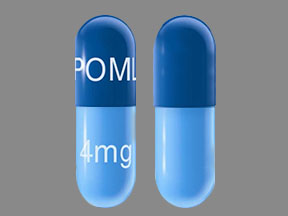Pomalyst Disease Interactions
There are 7 disease interactions with Pomalyst (pomalidomide).
- Thromboembolism
- Hematologic toxicities
- Hepatic impairment
- Neuropathy
- Renal impairment
- Smoking
- Tumor lysis syndrome
Pomalidomide (applies to Pomalyst) thromboembolism
Major Potential Hazard, Moderate plausibility. Applicable conditions: Thrombotic/Thromboembolic Disorder, History - Thrombotic/Thromboembolic Disorder
Pomalidomide may cause venous thromboembolic events (deep venous thrombosis and pulmonary embolism) and arterial thromboembolic events (myocardial infarction and stroke). It is recommended to initiate precautionary actions to try to minimize all modifiable factors (e.g., hyperlipidemia, hypertension, smoking) in patients with known risk factors, including those with prior thrombosis. Thromboprophylaxis is recommended, and the choice of regimen should be based on the assessment of the patient's underlying risk factors.
References
- "Product Information. Pomalyst (pomalidomide)." QLT Phototherapeutics Inc (2013):
Pomalidomide (applies to Pomalyst) hematologic toxicities
Moderate Potential Hazard, Moderate plausibility. Applicable conditions: Bone Marrow Depression/Low Blood Counts
The use of pomalidomide has been associated with hematological toxicities, followed by anemia and thrombocytopenia. It is recommended to monitor patients for hematologic toxicities, especially neutropenia. Monitor complete blood counts weekly for the first 8 weeks and monthly thereafter and depending on findings, patients may require dose interruption and/or modification. Close monitoring is recommended.
References
- "Product Information. Pomalyst (pomalidomide)." QLT Phototherapeutics Inc (2013):
Pomalidomide (applies to Pomalyst) hepatic impairment
Moderate Potential Hazard, Moderate plausibility. Applicable conditions: Liver Disease
Pomalidomide is primarily metabolized in the liver by CYP450 1A2 and CYP450 3A4. Hepatic failure, including fatal cases, has occurred in patients treated with pomalidomide. Elevated levels of alanine aminotransferase and bilirubin have also been observed. Reduce the starting dose of pomalidomide by 25% (3 mg daily) in patients with mild to moderate hepatic impairment and by 50% (2 mg daily) in those patients with severe hepatic impairment. It is recommended to monitor liver function tests monthly and to stop treatment with pomalidomide upon elevation of liver enzymes. After return to baseline values, treatment at a lower dose may be considered.
References
- "Product Information. Pomalyst (pomalidomide)." QLT Phototherapeutics Inc (2013):
Pomalidomide (applies to Pomalyst) neuropathy
Moderate Potential Hazard, Moderate plausibility. Applicable conditions: Peripheral Neuropathy
The use of pomalidomide has been associated with the development of neuropathy. Therapy with pomalidomide should be administered cautiously in patients with or at risk for neuropathy. Monitor closely for signs and symptoms associated with neuropathy and evaluate patients accordingly.
References
- "Product Information. Pomalyst (pomalidomide)." QLT Phototherapeutics Inc (2013):
Pomalidomide (applies to Pomalyst) renal impairment
Moderate Potential Hazard, Moderate plausibility. Applicable conditions: hemodialysis
Pomalidomide pharmacokinetic parameters were not significantly affected in patients with moderate or severe renal impairment. Pomalidomide should be used with caution in patients with severe renal impairment requiring dialysis and it should be administered after the completion of hemodialysis on dialysis days as the exposure of the drug could be significantly increased. Dose modification, 25% dose reduction (3 mg daily) is recommended at the start of therapy in patients with severe renal impairment requiring dialysis. Close monitoring is recommended.
References
- "Product Information. Pomalyst (pomalidomide)." QLT Phototherapeutics Inc (2013):
Pomalidomide (applies to Pomalyst) smoking
Moderate Potential Hazard, Moderate plausibility.
Cigarette smoking reduces pomalidomide AUC by 32% due to CYP450 1A2 induction. Advise patients that smoking may reduce the efficacy of pomalidomide.
References
- "Product Information. Pomalyst (pomalidomide)." QLT Phototherapeutics Inc (2013):
Pomalidomide (applies to Pomalyst) tumor lysis syndrome
Moderate Potential Hazard, Moderate plausibility.
Tumor lysis syndrome (TLS) may occur in patients receiving pomalidomide. Patients with high tumor burden and those with high circulating lymphocyte counts of greater than 25 X 10^9/L have a higher risk of developing TLS. Monitor for signs and symptoms of TLS. Temporary interruption or discontinuation of therapy might be required.
References
- "Product Information. Pomalyst (pomalidomide)." QLT Phototherapeutics Inc (2013):
Pomalyst drug interactions
There are 378 drug interactions with Pomalyst (pomalidomide).
Pomalyst alcohol/food interactions
There is 1 alcohol/food interaction with Pomalyst (pomalidomide).
More about Pomalyst (pomalidomide)
- Pomalyst consumer information
- Check interactions
- Compare alternatives
- Pricing & coupons
- Reviews (3)
- Drug images
- Side effects
- Dosage information
- During pregnancy
- FDA approval history
- Drug class: miscellaneous antineoplastics
- Breastfeeding
- En español
Related treatment guides
Drug Interaction Classification
| Highly clinically significant. Avoid combinations; the risk of the interaction outweighs the benefit. | |
| Moderately clinically significant. Usually avoid combinations; use it only under special circumstances. | |
| Minimally clinically significant. Minimize risk; assess risk and consider an alternative drug, take steps to circumvent the interaction risk and/or institute a monitoring plan. | |
| No interaction information available. |
Further information
Always consult your healthcare provider to ensure the information displayed on this page applies to your personal circumstances.


